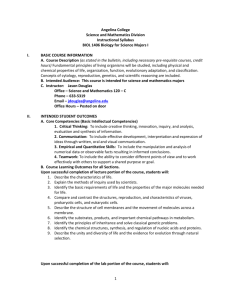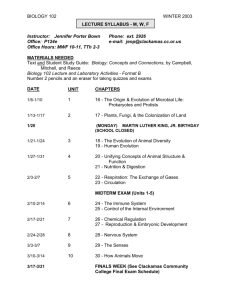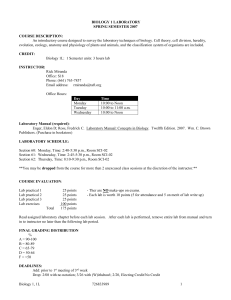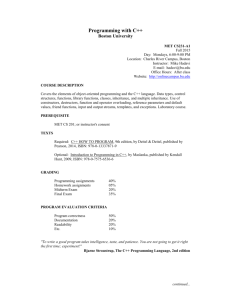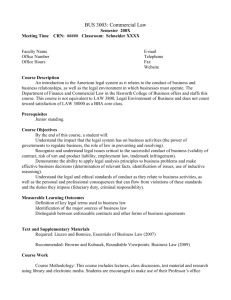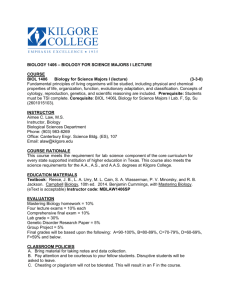Syllabus - Angelina College
advertisement
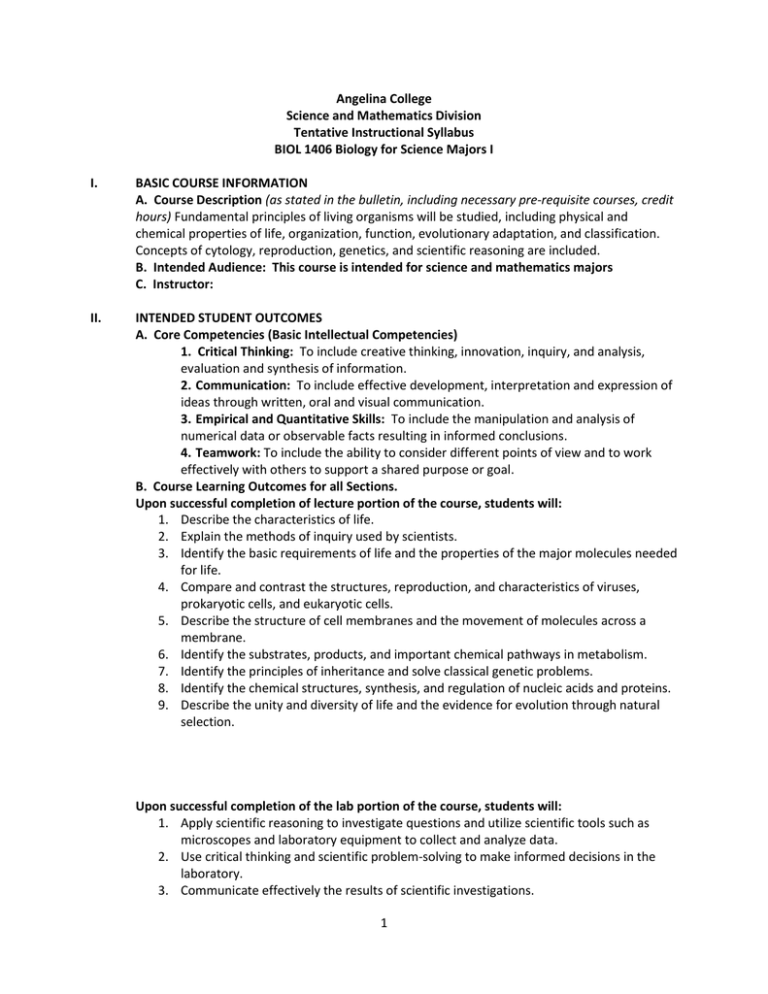
Angelina College Science and Mathematics Division Tentative Instructional Syllabus BIOL 1406 Biology for Science Majors I I. BASIC COURSE INFORMATION A. Course Description (as stated in the bulletin, including necessary pre-requisite courses, credit hours) Fundamental principles of living organisms will be studied, including physical and chemical properties of life, organization, function, evolutionary adaptation, and classification. Concepts of cytology, reproduction, genetics, and scientific reasoning are included. B. Intended Audience: This course is intended for science and mathematics majors C. Instructor: II. INTENDED STUDENT OUTCOMES A. Core Competencies (Basic Intellectual Competencies) 1. Critical Thinking: To include creative thinking, innovation, inquiry, and analysis, evaluation and synthesis of information. 2. Communication: To include effective development, interpretation and expression of ideas through written, oral and visual communication. 3. Empirical and Quantitative Skills: To include the manipulation and analysis of numerical data or observable facts resulting in informed conclusions. 4. Teamwork: To include the ability to consider different points of view and to work effectively with others to support a shared purpose or goal. B. Course Learning Outcomes for all Sections. Upon successful completion of lecture portion of the course, students will: 1. Describe the characteristics of life. 2. Explain the methods of inquiry used by scientists. 3. Identify the basic requirements of life and the properties of the major molecules needed for life. 4. Compare and contrast the structures, reproduction, and characteristics of viruses, prokaryotic cells, and eukaryotic cells. 5. Describe the structure of cell membranes and the movement of molecules across a membrane. 6. Identify the substrates, products, and important chemical pathways in metabolism. 7. Identify the principles of inheritance and solve classical genetic problems. 8. Identify the chemical structures, synthesis, and regulation of nucleic acids and proteins. 9. Describe the unity and diversity of life and the evidence for evolution through natural selection. Upon successful completion of the lab portion of the course, students will: 1. Apply scientific reasoning to investigate questions and utilize scientific tools such as microscopes and laboratory equipment to collect and analyze data. 2. Use critical thinking and scientific problem-solving to make informed decisions in the laboratory. 3. Communicate effectively the results of scientific investigations. 1 4. 5. 6. 7. 8. 9. 10. 11. 12. III. Describe the characteristics of life. Explain the methods of inquiry used by scientist. Identify the basic properties of substances needed for life. Compare and contrast the structures, reproduction, and characteristics of viruses, prokaryotic cells, and eukaryotic cells. Describe the structure of cell membranes and the movement of molecules across a membrane. Identify the substrates, products, and important chemical pathways in metabolism. Identify the principles of inheritance and solve classical genetic problems. Identify the chemical structures, synthesis, and regulation of nucleic acids and proteins. Describe the unity and diversity of life and the evidence for evolution through natural selection. ASSESSMENT MEASURES OF STUDENT LEARNING OUTCOMES A. Assessments for the Core Objectives a. Critical thinking – Students will analyze, compare, and contrast natural scientifically explained phenomena versus pseudoscientific thinking on that topic (i.e. HIV as the cause of AIDS versus HIV/AIDS denialism). Evidence of critical analysis will be assessed using a standardized AC rubric. b. Communication – Oral and visual communication will be assessed during a five to seven minute YouTube video or in class presentation. Written communication will be assessed based on an accompanying report to the presentation where students will present the bulk of their data or analysis. Communication skills and abilities will be assessed using a standardized AC rubric. c. Empirical and quantitative Skills – In comparing the assigned phenomena, students will compare and analyze the data presented in scientific articles. Students will also design an experiment to test underlying scientific theory where applicable. Their findings will be presented orally and in written format. Empirical and quantitative skills will be evaluated using a AC standardized rubric. d. Teamwork – Students will be assigned to teams. Each team will be assigned specific set of scientific /pseudoscientific phenomena and use the scientific literature available to analyze and compare. Team members will work together to define the roles of each member, will collaborate to share information and generate a meaningful synopsis of the compared works. Team members will evaluate the performance of one another using standardized AC rubric. B. Assessments for the Course Learning Outcomes for all Sections Assessment for the Course Learning Objectives will use embedded test questions on quizzes and the two (2) major exams 2 IV. INSTRUCTIONAL PROCEDURES This course will be taught using a combination of lectures and laboratory exercises that complement and supplement lecture material. Audio-visual materials, models, and laboratory experiments will be employed to enhance lecture and laboratory presentations. V. COURSE REQUIREMENTS AND POLICIES A. Required Textbooks, Materials, and Equipment Biology: How Life Works, Morris, Hartl, Knoll, Lue 1st edition Textbook’s web portal access http://www.whfreeman.com/launchpad/morris1e/96092 Biology 1406 Laboratory manual (Available in the AC bookstore) B. Additional Text (s) and Supplementary Materials for the Individual Instructor C. Course Policies – (This course conforms to the policies stated in the AC Handbook.) Academic Assistance – If you have a disability (as cited in Section 504 of the Rehabilitation Act of 1973 or Title II of the Americans with Disabilities Act of 1990) that may affect your participation in this class, you should see Karen Bowser, Room 208 of the Student Center. At a post-secondary institution, you must self-identify as a person with a disability; Ms. Bowser will assist you with the necessary information to do so. Attendance – All students are expected to attend all scheduled classes and examinations and to be on time. Students who know they will be absent in advance should contact the instructor as soon as possible by e-mail (preferred) or telephone. The instructor will determine whether or not an absence is excused. IT IS THE STUDENT’S RESPONSIBILITY TO DROP THE COURSE to avoid a potentially failing grade, however any student with 3 consecutive, or 4 cumulative absences may be dropped by the instructor regardless of the potential end of semester grade. The last day to drop the course with a “W” is (insert drop date). Attendance Policies Established by the Individual Instructor Insert personal course and attendance policies. Course Conduct 1. Absolutely no cell phone use is allowed during labs or class. 2. No Food, drinks, or tobacco in class. 3. Courteous and respectful behavior will be expected in class at all times. VI. TESTS, QUIZZES, AND EXTRA CREDIT Exam Format: Exams will be a mixture of short answer, multiple choice, matching and essay. Testing Procedures: On exam days students will only be allowed their Scantron, and pencil. All other belonging will need to be placed at the front of the class room * STUDENTS ARE REQUIRED TO PROVIDE THEIR OWN SCANTRONS (FORM 882-E) FOR EACH EXAM! Quizzes: Quizzes will be given periodically throughout the semester and will count as much as one exam. Extra Credit: Insert course specific extra credit policies & procedures. 3 VII. EVALUATION AND GRADING Lecture Points Homework Random Quizes (10) Exams (2) Midterm Final 550 100 100 100 100 150 Lab 250 Exam 1 Exam 2 Genetics Report 100 100 50 Pseudoscience Group Assignment Research Paper 100 Presentation 100 Peer Review 50 Points Total 1050 *Points are points. it does not matter where they come from, they all count equally. TOTAL PERCENTAGE FINAL GRADE 90+ % A 80 – 90% B 70 – 80% C 60 – 70% D *Point values will be adjusted in the event of utilizing embedded questions or modified activity. The instructor may modify the provisions of the syllabus to meet individual class needs by informing the class in advance as to the changes being made. 4 Biology 1406 Lecture Schedule Class # Chapter # Chapter Title 1 Chapter 1 Life 2 Chapter 2* Molecules of Life 3 Chapter 3* Nucleic Acids and Encoding of Biological information 4 Chapter 4 Translation and Protein Structure 5 Chapter 5 Organizing Principal 6 Organizing Principal 7 Chapter 6 Making Life Work 8 Chapter 7* Cellular Respiration 9 Cellular Respiration 10 Chapter 8* Photosynthesis 11 Photosynthesis 12 Midterm Review 13 Midterm Exam Chapter 1-8 14 Chapter 9 Cell Communication 15 Chapter 10 Cell Form and Function 16 Chapter 11 Cell Division 17 Chapter 12* DNA Replication and Manipulation 18 DNA Replication and Manipulation 19 Chapter 13* Genomes 20 Chapter 14 Mutation and DNA Repair 21 Chapter 15 Genetic Variation 22 Chapter 16* Mendelian Inheritance 23 Mendelian Inheritance 24 Chapter 17* Beyond Mendel 25 Chapter 18 The Genetic and Environmental Basis of Complex Traits 26 Chapter 19 Genetic and Epigenetic Regulation 27 Chapter 20* Genes and Development 28 Chapter 21* Evolution Final Exam 29 Review 30 Final Exam Comprehensive 5 Angelina College BIOL 1406 - General Biology Laboratory Syllabus The laboratory for Biology for Science Majors is designed to allow you to explore the world of biology hands-on. You will be able to see many of the things discussed in lecture and learn more about them. Attendance: Lab will be promptly at the assigned time. I expect you to be present and on time for every lab. You are required to stay in lab until you have completed all of the exercises for the assigned lab or until the lab formally concludes at the scheduled time. Lab Protocol: Come prepared for each lab (see instructions below). For each lab exercise, you may work with one or more students; however, I expect everyone to be a full working participant. Any time an answer is requested in an exercise, you must answer it on your lab write-up using your own words. Instructions are provided for each lab exercise. Read them carefully and proceed at your own pace. Answer all questions on the hand-outs given. Make any drawings requested in the lab manual, label all applicable structures in the drawings you make and on the sketches included in the lab manual. Study the demonstration materials available. When you have finished the lab exercises, clean your work area. Prepare your microscope for storage (see lab manual for instructions). Cover the microscope with the plastic bag/cover and return it to its proper location in the storage cabinet. Ask me any questions if you do not understand or are uncertain about any part of a lab exercise. I am here to help you learn. Lab Grade: The lab grade is based on the average of the lab exam scores and any written assignments given. Lab Preparation Requirements: - Bring your lab manual to each scheduled lab. - Be prepared to hand in your assignment over the previous week’s lab exercise. - Each lab will begin promptly at the scheduled time. 6 Biology 1406 Lab Schedule Room 125 Mondays @ 1:00pm-3:00pm Week Lab Activity Ex # 1 Introduction; Safety Training 1 2 Data Collection and Analysis 2 3 Chemical Composition of Cells 3 4 Cells and Diversity 4&5 5 Proteins and Enzymes 6 6 Photosynthesis 7 7 Lab Exam 1 8 Intro to Genetics and Molecular Methods Handout 9 Protein Purification I Handout 10 Protein Purification II Handout 11 DNA and Protein Electrophoresis 10 12 Transformation 11 13 Transformation 11 14 Lab Exam 2 7
